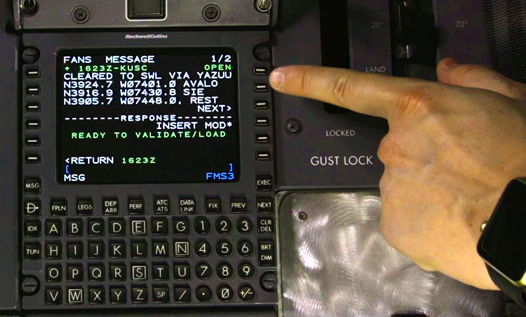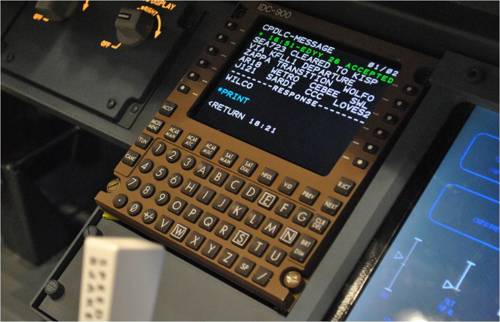
Equipping for digital air-to-ground messaging has been required for nearly a decade on the North Atlantic tracks and now it is taking domestic airspace and airports by storm in the US.
The FAA’s implementation of controller pilot data link communications (CPDLC) for clearance delivery at airports and en route services in domestic airspace is producing benefits for airlines and other aircraft operators. While voice communications are not going away and are still used for urgent communications and tactical air traffic control, the days of voice dominating air traffic control are now waning in the US.
“By exchanging digital messages in addition to talking to each other over the radio, air traffic controllers, pilots, and airline operations centers can communicate more clearly and efficiently. Better communication improves controller and pilot productivity, which enhances airspace capacity and reduces flight delays,” the FAA stated in its news release.
For over 10 years, L3Harris Technologies’ networks have enabled the deployment of an integrated CPDLC service for the US National Airspace System. Bringing an already extensive portfolio of capabilities in mission-critical air traffic management communications, the FAA and L3Harris partner to deploy and manage an integrated system of commercial air-to-ground service providers connected to FAA air traffic control facilities. The FAA calls this CPDLC capability their “Data Comm” system.
Now operational at 65 domestic air traffic control (ATC) towers, the rollout of Data Comm’s tower services came in under budget and more than two-and-a-half years ahead of schedule. Industry stakeholders view the program as a successful step in the FAA’s infrastructure modernization. Data Comm continues to roll out services to the en route airspace with twelve of the twenty planned domestic en route centers now running Data Comm services.
Benefits of CPDLC
In the USA, CPDLC is a benefits-driven program, meaning the entire initiative hinges on users investing in the technology based on the benefits case for its use. Unlike other new airspace technology initiatives such as Automatic Dependent Surveillance–Broadcast (ADS-B) which require all or nearly all aircraft equipped to realize full benefits, CPDLC can deliver benefits with only a portion of the aircraft equipped with the technology. The more aircraft that enable CDPLC, the more benefits are realized by airspace users.
The FAA began using CPDLC for departure clearances in 2016 and in en route airspace in 2019. It reports that as of 2023, there are 5,900 U.S. registered aircraft now equipped for CPDLC and they have saved nearly three million minutes of flying time while conducting more than 15 million flights using domestic CPDLC.
The benefits of the CPDLC system are tangible. When new departure clearances are issued via CPDLC, aircraft waiting to take off no longer need to burn fuel while listening to clearance delivery and reading back the new flight route. Pilots confirm clearances with the touch of a button that sends the response directly to the controller’s screen and provides the updated information for their flight management system. By reducing taxi delays on the ground and providing more efficient paths en route, the CPDLC system helps reduce the environmental impact of aviation through lowered carbon dioxide emissions. Since 2016, taxi delay savings have prevented over 41.5 million kilograms of carbon dioxide from entering the atmosphere.
Time is money when the engines are turning, and weather issues are a common problem that can cause major delays to daily flight schedules. These weather events can quickly affect a plane’s departure or en route flight. If a thunderstorm closes down a departure fix, controllers can issue new clearances in a rapid sequence to a dozen or more aircraft waiting in a line leading up to the active runway.

The same thing can occur en route when a rapidly developing line of thunderstorms closes down a route involving multiple aircraft. A series of new clearances can be quickly issued via CPDLC in rapid succession in a fraction of the time previously needed for processing over voice radio. The system’s ease of use allows these rapid changes to occur quickly.
In ATC voice communications, readback/hear-back errors between pilots and ATC occur regularly. This results in control instructions intended for one aircraft being taken by another and call signs getting transposed during the readback process, common mistakes that could take double or triple the amount of time to correct over voice. The enhancements from CPDLC allow a lot of these common mistakes to be avoided. However, voice will remain paramount for urgent communications which must be completed immediately.
Data Comm significantly decreases readback/hear-back errors by reducing the number of voice ATC instructions. Since 2016, Data Comm users have prevented more than 178 thousand readback errors – improving communication as well as boosting safety.
The symbiotic relationship between efficiency and safety realized through the deployment of CPDLC in the US National Airspace System has already provided clear benefits to all phases of the flight process, providing pilots, controllers, and passengers with a markedly better flying experience. Since the program’s start, CPDLC users have saved over four million minutes spent talking on voice radios and reduced approximately three million minutes of delay at the airport. Increased efficiency made possible by these services also provides measurable environmental benefits. By reducing taxi delays on the ground and providing more efficient paths en route, CPDLC helps reduce the environmental impact of aviation through lowered carbon dioxide emissions.
Industry collaboration
The widely acknowledged success of CPDLC in the US would not have been possible without the collaborative efforts of the Data Comm Implementation Team (DCIT).
Representatives from across the aviation industry, including pilots, controllers, air carriers, business aviation, aircraft manufacturers, avionics suppliers, labor unions, FAA, and supporting contractors, demonstrated effective planning, collaboration and decision-making resulting in the successful delivery of the program nationwide. DCIT members volunteered their deep aviation experience and vast industry knowledge to help vet implementation plans and share input at key decision points, resulting in the successful delivery of operational benefits to the NAS.

This collaboration began early in the program’s lifecycle when the working group convened to demonstrate the departure clearance capability using CPDLC in US airspace. The DCIT coordinated to implement the prototype systems to ensure the technology would work correctly for both controllers and pilots.
The collaborative relationship proved fruitful, as airline operators lined up to participate with their aircraft to help demonstrate the compatibility of the new data link application with different airplane models. The DCIT worked with project stakeholders throughout the process to hone procedures, perfect the wording of the DCL messages, and test the interoperability of the technology with various aircraft models.
The impact the DCIT continues to have on the aviation industry is astounding and encourages collaboration among the various stakeholders involved in the system’s success. They provided hands-on feedback on routes, altitudes, air traffic advisory messages, and speeds.
By participating in the DCIT, airspace users work together to improve the system for all operators, putting collaboration over individual interests. Even today, these industry players, often competitors, continue to share information about their own
operations for the betterment of the community.
Working together from across the industry, DCIT collectively writes documentation that is used as the guidance materials for education and training, leveraging the diverse knowledge and experiences of controllers, pilots, engineers and more. These documents are published for industry use.
Within the forum, working groups address specialized topics for collaborative recommendations. The dispatch working group helped operators create and maintain more efficient flight planning processes to maximize Data Comm’s operational success.
The avionics working group helped focus the avionics community on the improvements required as a result of the observed behavior in the operation of Data Comm. In addition the flight deck working group frequently collaborates on word and phrase selection in order to improve CPDLC uplink messages for suitability in the field.
Enabling airspace enhancements

The adoption of departure clearances and now initial en route CPDLC services paves the way for future enhancements to the way aircraft will navigate. In the USA, the FAA has been incrementally working towards deploying 4-Dimensional Trajectory Based Operations which will provide a seamless end-to-end operation for all aircraft navigating the National Airspace System
Similar efforts in Europe are underway, and these enhancements will provide greater access and more efficient operations through ever-increasingly congested and complex airspace. One of the foundational keys to enabling these enhancements is CPDLC, providing a fast, efficient, and safe method that enables aircraft and ATC to communicate in an increasingly complex environment.
The return of air travel post-pandemic has yielded unprecedented demand on airspace systems around the world, and enhancements are needed now more than ever to minimize delays and ensure the most efficient use of airspace. Enhancements such as CPDLC have already provided benefits to mitigating delays that even three years ago were not available.
Fully integrated CPDLC services such as Data Comm in the USA provide a seamless integration that allows air navigation
service providers to provide enhanced services to airspace users while streamlining cost and implementation complexity.
These types of collaborative and integrated programs benefit all aspects of aviation. With CPDLC, the sky is truly the limit.
